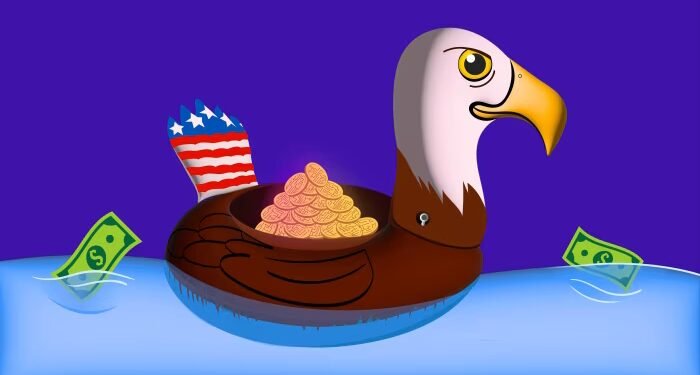Unlock the White Home Watch e-newsletter without cost
Your information to what Trump’s second time period means for Washington, enterprise and the world
A 12 months in the past, Stephen Miran, the previous chair of the Council of Financial Advisers beneath US President Donald Trump and now a Federal Reserve governor, wrote a paper that brought about a frisson within the monetary markets.
Miran instructed, in a spirit of Socratic debate, that Trump might use tariffs and a “Mar-a-Lago” foreign money accord to bolster American dominance — an thought which provoked horror amongst progressives and free-market economists alike.
Twelve months on, Trump has obviously embraced tariffs. And whereas the Mar-a-Lago foreign money imaginative and prescient has pale from view, Miran is now tossing out new concepts — and his opponents ought to take notice. For he thinks we’re about to see a notable shift in monetary flows that might have an effect on greenback utilization and rates of interest. Name this, for those who like, a brand new chapter in geofinance — or American monetary imperialism.
The essential problem is stablecoins, or cryptocurrencies backed by different belongings. Till just lately, many financiers dismissed these as a sideshow or, worse, a legal software. No surprise: Tether, the most important stablecoin issuer, has beforehand confronted legal censure. Nonetheless the Trump administration has backed stablecoins. Not uncoincidentally, Howard Lutnick, commerce secretary, has ties to Tether. And Congress just lately adopted a stablecoin regulatory framework, the Genius Act.
The Treasury division is now turning this into guidelines, sparking behind-the-scenes battles. Many trade gamers need to create yield-bearing stablecoins. Nonetheless, US financial institution chiefs, like their UK counterparts, are fiercely opposed, since it would suck away their deposits, because the Treasury Bond Advisory Committee has acknowledged.
I count on the banks to win. And Miran appears to agree: he told the UK Cambridge Choose Enterprise Faculty this week that demand for stablecoins will most likely keep muted contained in the US, if these don’t provide yields. “I count on a lot of the uptake [for stablecoins],” he noticed, “to come back from locations the place they’ll’t entry greenback devices” — like many rising markets.
Nonetheless, even with these constraints, gamers corresponding to Customary Chartered predict that the stablecoin sector will develop from $280bn to $2tn by 2028, whereas Treasury secretary Scott Bessent tasks $3tn by 2030. And for the reason that Genius Act requires “100 per cent reserve backing with liquid belongings”, this may create new demand for greenback bonds.
Certainly Miran predicts that what he calls a future “global stablecoin glut” will bolster this demand on a scale that’s corresponding to the Fed’s current quantitative easing programmes. “[This] might put as a lot as 40 foundation factors of downward strain on [US] rates of interest”, he concludes, noting that the shift might additionally equate to one-third (or extra) of the worldwide “financial savings glut” that former Fed chair Ben Bernanke described in 2005 (and which poured into greenback belongings and pushed down rates of interest).
This can be a markedly completely different future from the one outlined earlier this 12 months by Isabel Schnabel, a member of the chief board of the European Central Financial institution, who fears “that we’re transitioning from a worldwide “financial savings glut” in the direction of a worldwide “bond glut”, the place extra western debt raises long-term prices. And critics may problem Miran’s optimism on charges.
However a recent IMF report notes that in late 2024 — ie earlier than Trump’s return to the White Home — the 2 largest stablecoins, Tether and Circle, already held extra Treasuries than both Saudi Arabia or Germany, and had virtually eclipsed Norway. Since then, their holdings have most likely surged.
This, in flip, has implications for the buck. Since Trump took workplace, hypothesis about de-dollarisation has swelled on account of sky-high US debt and geopolitical fracture. However Miran advised Choose that the adoption of greenback stablecoins in rising markets might “advocate towards this de-dollarisation hype”. Or as Marina Azzimonti and Vincenzo Quadrini, two economists, recently noted: “The exorbitant privilege of the greenback shall be strengthened by the expansion of Stablecoins.”
In that case, this might clearly delight Trump. It may additionally horrify different nations. “For the remainder of the world, together with Europe, huge adoption of US greenback stablecoins for fee functions can be equal to the privatization of seigniorage by international actors,” notes Hélène Rey, an economist, who fears rising “tax evasion” and “decrease demand for non-US authorities bonds”.
To place it one other method, Schnabel’s prediction of a “bond glut” may develop into right — however just for non-US bonds. The embrace of stablecoins might depart Europe or many rising markets newly weak.
Will this occur? Trump critics may assume, or hope, not. And a few economists are apt to dismiss Miran as a political acolyte of the president, significantly since he has just lately known as for a lot decrease US interest rates.
However I, for one, assume the latter criticism is flawed. Miran’s evaluation displays his strongly held mental framework and curiosity, not simply political expediency. And the important thing level is that Trump’s group desires to bolster US monetary hegemony in a world of geoeconomic upheaval. So love or hate Miran’s new predictions, traders ignore them at their peril — no matter does (or doesn’t) occur with that putative Mar-a-Lago accord.
Source link






